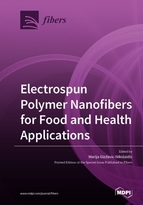Electrospun Polymer Nanofibers for Food and Health Applications
A special issue of Fibers (ISSN 2079-6439).
Deadline for manuscript submissions: closed (30 September 2019) | Viewed by 33186
Special Issue Editor
Special Issue Information
Dear Colleagues,
The electrospinning method has the unique ability to produce structured polymeric fibers on the micro or nano scale and to generate novel materials for food and healthcare purposes. The potential of electrospun nanofibers for human healthcare applications is promising, for example, in tissue/organ repair and regeneration, as vectors to deliver drugs and therapeutics, as biocompatible and biodegradable medical implant devices, in medical diagnostics and instrumentation, as protective fabrics against environmental and infectious agents in hospitals and general surroundings, and in cosmetic and dental applications. Furthermore, considerable effort has been directed toward developing scaffolds using biodegradable and biocompatible synthetic, natural polymers or renewable materials that enhance in vitro cell growth, while killing pathogenic bacteria cells. The electrospun fibrous mats generally exhibit a large surface area to volume ratio due to the high porosity and nano to sub-micron structure of the fibres. The advent of electrospinning has opened up new prospects for the development of architectured materials with enhanced properties for applications such as food packaging, food encapsulation, food storage or the food processing of agricultural products. This Special Issue details current research in this field, focusing on the development of electrospun polymer nanofibers for food and health applications.
Dr. Marija Gizdavic-Nikolaidis
Guest Editor
Manuscript Submission Information
Manuscripts should be submitted online at www.mdpi.com by registering and logging in to this website. Once you are registered, click here to go to the submission form. Manuscripts can be submitted until the deadline. All submissions that pass pre-check are peer-reviewed. Accepted papers will be published continuously in the journal (as soon as accepted) and will be listed together on the special issue website. Research articles, review articles as well as short communications are invited. For planned papers, a title and short abstract (about 100 words) can be sent to the Editorial Office for announcement on this website.
Submitted manuscripts should not have been published previously, nor be under consideration for publication elsewhere (except conference proceedings papers). All manuscripts are thoroughly refereed through a single-blind peer-review process. A guide for authors and other relevant information for submission of manuscripts is available on the Instructions for Authors page. Fibers is an international peer-reviewed open access monthly journal published by MDPI.
Please visit the Instructions for Authors page before submitting a manuscript. The Article Processing Charge (APC) for publication in this open access journal is 2000 CHF (Swiss Francs). Submitted papers should be well formatted and use good English. Authors may use MDPI's English editing service prior to publication or during author revisions.
Keywords
- electrospinning
- polymer blend
- biomaterials
- microfibres/nanofibres
- scaffolds
- electrospun fibres
- eletrospun fibre mats
- electrospun green fibres
- bioactive electrospun fibres
- electrospun edible fibres
- natural polymer-based electrospun fibres
- tissue engineering
- food packaging
- wound dressing
- encapsulation
- agriculture
- food industry
- drug release






